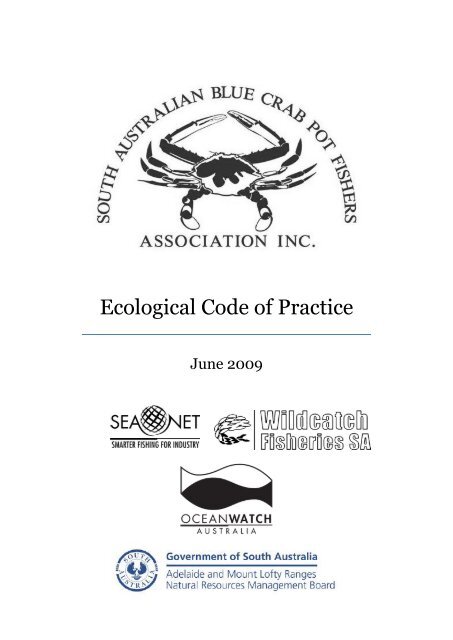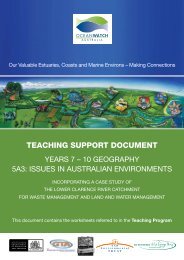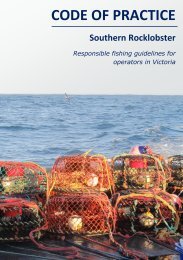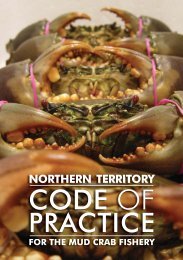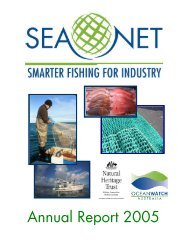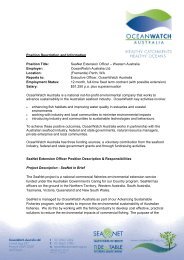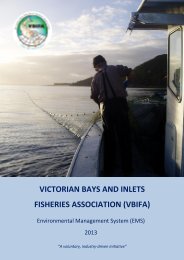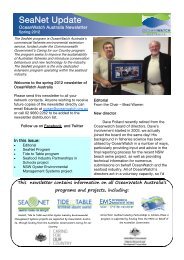Blue Crab Pot Fishers Ecological Code of Practice - OceanWatch ...
Blue Crab Pot Fishers Ecological Code of Practice - OceanWatch ...
Blue Crab Pot Fishers Ecological Code of Practice - OceanWatch ...
Create successful ePaper yourself
Turn your PDF publications into a flip-book with our unique Google optimized e-Paper software.
<strong>Ecological</strong> <strong>Code</strong> <strong>of</strong> <strong>Practice</strong><br />
June 2009
PREFACE<br />
South Australia is blessed with unique<br />
marine environments that support a<br />
variety <strong>of</strong> valuable natural resources<br />
including fisheries. The sustainability <strong>of</strong><br />
our marine environment is under<br />
pressure from a variety <strong>of</strong> human<br />
activities. Modified or damaged marine<br />
ecosystem support fewer species, have<br />
lower productivity, and produce an<br />
inferior product. Therefore, the<br />
pr<strong>of</strong>essional fishers <strong>of</strong> the South<br />
Australian <strong>Blue</strong> <strong>Crab</strong> <strong>Pot</strong> <strong>Fishers</strong><br />
Association Inc. (SABCPFA) are<br />
committed to the <strong>Ecological</strong> Sustainable<br />
Development (ESD) <strong>of</strong> their industry.<br />
In the South Australian commercial <strong>Blue</strong> <strong>Crab</strong> Fishery (BCF) ‘<strong>Pot</strong> Fishing’ is the<br />
fishing technique employed because <strong>of</strong> its flexibility, accuracy, and selectivity.<br />
<strong>Fishers</strong> <strong>of</strong> the SABCPFA recognise that irresponsible use <strong>of</strong> this tool also has the<br />
potential to cause negative impacts on the marine environment. It is a priority<br />
<strong>of</strong> the SABCPFA to understand potential risks and develop strategies to<br />
mitigate them. Through the SABCPFA fishers have developed the following<br />
<strong>Ecological</strong> <strong>Code</strong> <strong>of</strong> <strong>Practice</strong> (COP) in partnership with Wildcatch Fisheries SA<br />
(WFSA), <strong>OceanWatch</strong> ‘SeaNet’ program, input from Primary Industries and<br />
Resources SA (PIRSA), and the financial support <strong>of</strong> Adelaide and Mt. L<strong>of</strong>ty<br />
Ranges Natural Resource Management Board (AMLR NRMB).
CONTENTS<br />
PREFACE ............................................................................................................................. 2<br />
CONTENTS .......................................................................................................................... 3<br />
SCOPE OF THE CODE ........................................................................................................ 1<br />
THE SOUTH AUSTRALIAN BLUE CRAB FISHERY ............................................................. 2<br />
THREATENED ENDANGERED AND PROTECTED SPECIES ............................................ 3<br />
Injured Stranded or Dead TEP species ................................................................................................ 4<br />
FISHING OPPERATIONS ..................................................................................................... 5<br />
Gear Design......................................................................................................................................... 5<br />
Marking and Maintaining gear ........................................................................................................... 7<br />
Setting and Hauling <strong>Pot</strong>s ..................................................................................................................... 8<br />
Bait ...................................................................................................................................................... 9<br />
Soak Times ........................................................................................................................................ 10<br />
WASTE MANAGEMENT ..................................................................................................... 10<br />
HANDLING AND RELEASING ............................................................................................ 11<br />
Fish & Sharks ..................................................................................................................................... 11<br />
Mammal ............................................................................................................................................ 11<br />
Turtles ............................................................................................................................................... 11<br />
INTRODUCED MARINE PESTS ......................................................................................... 12<br />
Glossary <strong>of</strong> terms ................................................................................................................ 14<br />
Acronyms ............................................................................................................................ 14<br />
CONTACTS ........................................................................................................................ 15<br />
Industry Information ........................................................................................................................ 15<br />
Management and Research .............................................................................................................. 16<br />
Emergency & Pollution ..................................................................................................................... 17<br />
Animal Information........................................................................................................................... 18
SCOPE OF THE CODE<br />
Management directives <strong>of</strong>ten focus on<br />
negative aspect <strong>of</strong> fishing operations,<br />
‘what pr<strong>of</strong>essional fishers are not to do’<br />
in contrast this COP which aims at<br />
highlighting the positive things that<br />
‘pr<strong>of</strong>essional fishers can do’ to improve<br />
their environmental footprint. It also<br />
provides a reference for all stakeholder<br />
groups and the wider community <strong>of</strong> how<br />
the pr<strong>of</strong>essional pot fishers <strong>of</strong> the<br />
SABCPFA are addressing the following<br />
environmental issues relating to their<br />
fishing operations:<br />
Image Dr. Richard Muscgrove<br />
Threatened Endangered and Protected Species<br />
Handling and release<br />
Waste Management<br />
Introduced Marine Pests Species<br />
For the purpose <strong>of</strong> the code “pot fishing” is a generic term use to describe the<br />
techniques use in the South Australian <strong>Blue</strong> <strong>Crab</strong> Fishery. There are specific<br />
management criteria that determine the dimensions <strong>of</strong> a commercial blue crab<br />
pot according to PIRSA Fisheries Management Regulations (General) 2008. The<br />
code <strong>of</strong> ecological practice is a living document which will be review annually<br />
by the SABCPFA and external stakeholders will be asked to evaluate any<br />
updates.<br />
1
THE SOUTH AUSTRALIAN BLUE CRAB FISHERY<br />
Commercial fishing is a key primary industry in South Australia (SA), producing a<br />
variety <strong>of</strong> high quality seafood products for consumers and supporting local<br />
communities through important employment chains. Commercial pot fishers in the<br />
SA <strong>Blue</strong> <strong>Crab</strong> <strong>Pot</strong> Fishery supply fresh and cooked crabs for sale to local and domestic<br />
and overseas consumers with sales in excess <strong>of</strong> five million dollars in 2006/07.<br />
Historically, blue swimmer crabs were taken as bycatch in a number <strong>of</strong> other<br />
fisheries including the prawn trawling and the marine scalefish fisheries. In the early<br />
80’s a move was made to develop a stand alone <strong>Blue</strong> <strong>Crab</strong> Fishery (BCF) in SA. This<br />
was initiated by the allocation <strong>of</strong> a number <strong>of</strong> experimental licenses and the banning<br />
<strong>of</strong> blue crabs as permissible by-product in the prawn fisheries. It was soon recognised<br />
that commercial viable populations <strong>of</strong> blue swimmer crabs occurred in both the<br />
Spencer Gulf and St. Vincent Gulfs. In contrast the Far West Coast only supported a<br />
seasonally opportunistic fishery. The stocks within each gulf have little or no<br />
interaction and are viewed and managed as separate stocks within the one fishery.<br />
In 1996 PIRSA initiated a number <strong>of</strong> management and research strategies for the<br />
further development <strong>of</strong> the BCF in South SA. The current arrangements include a<br />
number <strong>of</strong> strategies to control effort in each gulf including: limited entry, temporal<br />
and spatial restrictions and quota<br />
The BCF employs seasonal closures in both gulfs and fishery boundaries. The total<br />
catch for each gulf is capped by means <strong>of</strong> a Total Allowable Commercial Catch (TACC)<br />
which, the BCF Management Committee (MCFMC) reviews annually. Currently, there<br />
are eight commercial BCF License holders, five in Spencer Gulf and three in St.<br />
Vincent Gulf. Since early 90’s the South Australian <strong>Blue</strong> <strong>Crab</strong> <strong>Pot</strong> <strong>Fishers</strong> Association<br />
Inc. (SABCPFA) has represented their interests. The SABCPFA is comprised <strong>of</strong><br />
voluntary members, an elected president and an appointed executive <strong>of</strong>ficer.<br />
SABCPFA are also are an integral part <strong>of</strong> the industry peak body Wildcatch Fisheries<br />
SA (WFSA), through their appointed council member.<br />
These industry representatives are working with Primary Industries and Resources<br />
South Australia (PIRSA)(regulative body) toward the social, economic, and<br />
environmental sustainable development <strong>of</strong> the industry. By developing avenues that<br />
can further resource sharing, knowledge exchange, and improved efficiency.<br />
2
THREATENED ENDANGERED AND PROTECTED SPECIES<br />
To help maintain Australia’s’ rich and unique<br />
biodiversity, special Commonwealth laws<br />
were enacted, which make up the,<br />
Environment Protection and Biodiversity<br />
Conservation Act 1999 (EPBC Act). This Act<br />
includes reference to a number <strong>of</strong> listed<br />
species that are; Threatened, Endangered,<br />
and Protected species (TEPS). On this list are a<br />
number <strong>of</strong> marine species which are resident<br />
or seasonal visitors to SA’s gulfs and coastal<br />
waters. They include; seals, sealions, whales,<br />
turtles, seabirds, and particular shark species.<br />
A comprehensive list and ID guides (pictured<br />
below) they are available from The National<br />
Heritage Trust at:<br />
www.environment.gov.au/coasts/publications/identification-guide<br />
The following categories describe the status <strong>of</strong> a listed animal and intern a level <strong>of</strong><br />
protection provided, in general terms these categories can be interpreted:<br />
As TEP species recover form decline it is inevitable that interactions with human<br />
activities will increase in the future. <strong>Fishers</strong> recognise that increased competition for<br />
a common marine resource with wild animals will also increase the risk <strong>of</strong><br />
interactions with TEP species. An interaction is classed as any contact operators have<br />
with a protected species, including hooking, entangling, landing, or collision with<br />
vessel or gear.<br />
It is not an <strong>of</strong>fence to have incidental interaction with a TEP species, but it is an<br />
<strong>of</strong>fence to fail to notify the correct authorities<br />
3
To manage these risks fishers are obliged to:<br />
Abide by all legislated and license conditions pertaining to TEP species<br />
Recording and reporting interactions appropriate details in their logbook<br />
(including a specific TEPS logbook)<br />
Record and report appropriate details to Department <strong>of</strong> Environment, Water<br />
Heritage and the Arts (DEWHA) on: Phone: 1800 641 806; or email:<br />
protected.species@environment.gov.au<br />
Remain informed on local TEP species and procedures available<br />
INJURED STRANDED OR DEAD TEP SPECIES<br />
While interaction with TEP species are rare you may in the corse <strong>of</strong> fishing or<br />
travelling to fishing grounds, come across a stranded, injured, or dead animal. You<br />
may also witness an animal being harassed. <strong>Fishers</strong> should record the following<br />
details and contact FISHWATCH and community groups (see Contacts on page 10. for<br />
appropriate details)<br />
What they need to know:<br />
Location and number <strong>of</strong> animals<br />
Species involved, description and size <strong>of</strong> animals<br />
When the stranding or incident occurred, or when the animal was first<br />
discovered<br />
The weather conditions now and expected<br />
Tide details<br />
Accessibility by boat/vehicle<br />
Name and contact details <strong>of</strong> person who first reported the event if not<br />
yourself<br />
If the animals are being harassed, the nature <strong>of</strong> the harassment, the identity<br />
or description <strong>of</strong> the person or people involved, registration numbers <strong>of</strong> cars<br />
or boats involved<br />
Any other details which may be relevant<br />
4
FISHING OPPERATIONS<br />
The SABCPFA represents a diversity <strong>of</strong> fishers<br />
each with their own unique experience and<br />
knowledge <strong>of</strong> their particular marine<br />
environment. This experience has shaped<br />
individual ‘fishing operations’ that are<br />
specifically suited their particular;<br />
infrastructure (vessel and gear), local<br />
environment, market forces, and management<br />
directives.<br />
Image Dr. Richard Muscgrove<br />
As a result few fishers will operate in the same<br />
way. Therefore, the following heading highlight<br />
a generic, ‘<strong>Pot</strong> Fishing Operation’ and discusses<br />
associated environmental issues and puts<br />
forward suggestions from fishers as practical<br />
and effective strategies to mitigate them.<br />
GEAR DESIGN<br />
<strong>Fishers</strong> <strong>of</strong> the SABCPFA are committed to ESD and the continued improvement <strong>of</strong><br />
their environmental performance by embrace emerging technologies and gear<br />
design. While gear design remains a personal matter there are some simple<br />
strategies that can be employed to further reduce the likelihood <strong>of</strong> entanglement<br />
with marine mammals.<br />
<strong>Fishers</strong> <strong>of</strong> the SABCPFA have pioneered techniques to that reduce the number <strong>of</strong><br />
float lines in the water column and intern the number floats at the surface. By joining<br />
a number <strong>of</strong> pots together with ‘linking-lines’, made <strong>of</strong> weighted sinking rope to<br />
reduce loose line in the water column (below). <strong>Fishers</strong> also use ‘float-line’ lengths<br />
that are specific to the water depth being fished to reduce slack line in the water<br />
column.<br />
Marine mammals can also be warned <strong>of</strong> the presence <strong>of</strong> fishing gear acoustically.<br />
Devices, known as ‘pingers’ emit pulses <strong>of</strong> sound underwater, sound that can be<br />
tailored to target specific animals eg: Cetaceans (whales & dolphins). The success<br />
and practicality <strong>of</strong> this and other emerging technologies are being trailed by a<br />
number <strong>of</strong> <strong>Pot</strong> fishers <strong>of</strong> the SABCPFA.<br />
5
MARKING AND MAINTAINING GEAR<br />
<strong>Fishers</strong> take all practical measures to mark and maintain their gear to a high<br />
standard, to maintain efficiency and safeguard their investment. Appropriate<br />
marking <strong>of</strong> gear coupled with reducing the number <strong>of</strong> floats at the surface can<br />
dramatically reduce the likelihood <strong>of</strong> incidental boat strike.<br />
<strong>Pot</strong> fishing s a technique that requires significant infrastructure, including: pots, bait<br />
baskets, floats (buoys), float-lines, and linking-lines. Whole or partial loss <strong>of</strong> this gear<br />
can pose significant and ongoing entanglement issues for wildlife and other vessels.<br />
Lost pots can also continue to ‘ghost fish’ as trapped animals attract others who<br />
intern become trapped. This cycle will continue until the integrity <strong>of</strong> the pot is<br />
broken down, which can take considerable amount <strong>of</strong> time. To avoid ghost fishing<br />
pots can be constructed to fail at specific points if lost.<br />
<strong>Fishers</strong> can utilise the following strategies:<br />
Ensure all gear complies with licence conditions<br />
Monitor the condition <strong>of</strong> gear at regular intervals (don’t wait for something<br />
to break)<br />
Display appropriate information on floats, eg: (license number, vessel name<br />
or call sign)<br />
Increase visibility <strong>of</strong> floats at night or in low light eg: (strobes or reflective<br />
tape)<br />
Utilise a pot design that eliminates ghost fishing<br />
7
SETTING AND HAULING POTS<br />
The setting (deployment) and hauling<br />
(retrieval) <strong>of</strong> pots are fishing operations that<br />
fishers <strong>of</strong> the SABCPFA have direct control<br />
over. Responsible practices can significantly<br />
reduce the risk <strong>of</strong> interactions with Thretend,<br />
Endangered and Protected Species. In<br />
addition, this is a labour intensive operation<br />
that poses unique health and safety risks to<br />
employees.<br />
The best strategies to mitigate interactions<br />
with large marine mammals are to simply<br />
avoid them and or areas they frequent.<br />
The following are some simple strategies that<br />
can be utilised to minimise these risks.<br />
Image Dr. Richard Muscgrove<br />
<strong>Fishers</strong> can use the following strategies to reduce safety risks:<br />
Monitoring weather forecast to avoid dangerous conditions<br />
Plan setting course with hauling weather conditions and direction in mind<br />
Avoiding setting gear near known snags and structures<br />
Avoiding high traffic areas and possible interactions with other vessels<br />
<strong>Fishers</strong> can use the following strategies to mitigate TEP interactions:<br />
Avoiding areas that TEP species are known to frequent<br />
Avoiding setting gears when protected specific species have been sighted<br />
Avoid discharge <strong>of</strong> bait ,<strong>of</strong>fal, and dead bycatch until hauling is complete<br />
Trial species specific Pingers on float head lines<br />
.<br />
8
BAIT<br />
Many fishers have license endorsements<br />
entitling them to collect bait species eg: Each<br />
endorsement has specific conditions<br />
including size and daily limits and<br />
specifications for the size and shape <strong>of</strong><br />
collection tools. In addition to these<br />
requirements fishers also consider the<br />
sustainability <strong>of</strong> their valuable bait resources<br />
by monitoring stock levels and mitigating the<br />
spread unwanted disease and Introduced<br />
Marine Pests (IMPS).<br />
While bait seems like a benign part <strong>of</strong> the<br />
fishing operation it can pose a number <strong>of</strong><br />
environmental risks. Discarded bait can<br />
attract scavenging species which can lead to<br />
changes in feeding behaviours and<br />
Image Dr. Richard Muscgrove<br />
dependence. This is a particular problem as it<br />
can lead to increased interactions with TEP species such as seals, sea lions, and<br />
dolphins and birds. Imported bait also has the potential to spread unwanted disease<br />
and introduced marine pests.<br />
To reduce these risk fishers can undertake the following strategies:<br />
Retain used bait onboard the vessel, disposing it only once the vessel has<br />
left the fishing grounds and under way<br />
Use local bait where possible to reduce the risk <strong>of</strong> spreading pests and<br />
diseases and to support local businesses<br />
Where other gear is used to collect bait, ensure that gear is endorsed on the<br />
License and is within the relevant specifications<br />
Ensure it is cleaned well to reduce the chance <strong>of</strong> spreading IMPS to other<br />
areas<br />
9
SOAK TIMES<br />
Soak time is the amount <strong>of</strong> time the gear is in the water. Some <strong>of</strong> the ecological risks<br />
associated with soak times include: wastage <strong>of</strong> target species through predation,<br />
decreased survival <strong>of</strong> by-catch species, and increased chance <strong>of</strong> entanglement <strong>of</strong><br />
protected species in the gear. While taking into account the geographical location<br />
and time <strong>of</strong> year, fishers should aim to reduce soak time to as short as practical<br />
WASTE MANAGEMENT<br />
Pollution <strong>of</strong> the marine environment by vessels can cause significant environmental<br />
impacts. Plastics entering the water do not readily degrade, increasing the likelihood<br />
negative impacts on marine animals through entanglement or ingestion. Chemical<br />
wastes do not break down easily and can have serious and ongoing detrimental<br />
effects on marine animals and their habitat. To manage these risks fishers are<br />
obligated by law to abide by the; International Convention for the Prevention <strong>of</strong><br />
Pollution from Ships, 1973, as modified by the Protocol <strong>of</strong> 1978 relating thereto<br />
(MARPOL).<br />
Therefore, these wastes are carefully stowed onboard and disposed <strong>of</strong> by fishers <strong>of</strong><br />
the SABCPFA at appropriate onshore waste disposal centres to ensure that there is<br />
no damage to the marine environment. In addition to MARPOL compliance there are<br />
a number <strong>of</strong> simple techniques that can reduce the impact <strong>of</strong> these wastes on the<br />
environment, and reduce costs to the business.<br />
The following are waste management strategies that fishers can employ:<br />
Regularly review waste management procedures, with the view to reduce,<br />
reuse and recycle<br />
Have waste stowage provisions that are convenient and vessel appropriate<br />
eg: (bins with lids or bags)<br />
Retain all tangled or damaged components for repair, reuse, or appropriate<br />
disposal onshore<br />
Avoid discharging biological wastes while setting or hauling and dispose <strong>of</strong> it<br />
while steaming away or between fishing grounds<br />
10
HANDLING AND RELEASING<br />
FISH & SHARKS<br />
In day to day fishing appropriate handling <strong>of</strong><br />
undersize, bycatch, or no-take species will increase<br />
their survival rate after release. Also In the unlikely<br />
event <strong>of</strong> an entanglement with a TEP species it is<br />
crucial to know what to do and there are a number<br />
<strong>of</strong> proven techniques. These techniques will not<br />
only increase survival rates but also reduce safety<br />
risks to the vessel and crew. The SeaNet Protected<br />
Species Handling Manual 2005 (pictured below)<br />
provides detailed descriptions and diagrams for<br />
handling and release strategies, as well as tools that<br />
are available to fishers that enhance a safe and<br />
efficient release and has been provided to fishers<br />
Minimise handling <strong>of</strong> bycatch and undersize target species <strong>of</strong> fish and shark - this will<br />
reduce the risk <strong>of</strong> mortality after release. <strong>Fishers</strong> should also avoid landing large<br />
animals, cutting lines while the animal is in the water will minimise damage to the<br />
animal, danger to the crew, or fishing infrastructure<br />
MAMMAL<br />
Due to their size entangled marine mammals can be difficult and dangerous to<br />
handle, always consider crew safety when attempting to release marine mammals. If<br />
removal <strong>of</strong> entanglement is not possible or beyond the capacity <strong>of</strong> the vessel, record<br />
the appropriate details and contact the relevant authorities.<br />
TURTLES<br />
Contrary to popular belief a number <strong>of</strong> sea turtles species do frequent the coastal<br />
and gulf waters <strong>of</strong> SA. Entangled or trapped turtles may appear dead or lifeless<br />
however, they may indeed be in a comatose state. If possible bring all turtles<br />
onboard and asses for signs <strong>of</strong> life, turtles can be revived using techniques outlined<br />
in the above manual. If conscious carefully, remove all gear and release the animal, if<br />
not possible bring it into port for appropriate treatment (see contact details, page<br />
16).<br />
11
INTRODUCED MARINE PESTS<br />
Over 250 introduced marine plants and animals have hitch-hiked to Australian<br />
waters on vessels <strong>of</strong> all types from yachts to commercial ships. Introduced Marine<br />
Pest Species (IMPS) can displace native species leading to habitat and ecosystem<br />
alteration. This can have significant implications for commercial fishers ranging from<br />
costly infrastructure fouling or the complete collapse <strong>of</strong> a fishery. Introduced Marine<br />
Pest Species (IMPS) can be difficult to detect and the chance <strong>of</strong> eradicating them is<br />
low, control and maintenance costs <strong>of</strong> established species are significant and<br />
ongoing. Early detection and reducing the risks <strong>of</strong> moving exotic species are the best<br />
form <strong>of</strong> defence.<br />
<strong>Fishers</strong> <strong>of</strong> the MFA are aware <strong>of</strong> IMPS and are conscious <strong>of</strong> the role that they can<br />
play in the defence <strong>of</strong> their industry. Pr<strong>of</strong>essional fishers have untapped knowledge<br />
<strong>of</strong> their local area and can make a significant contribution to the early detection <strong>of</strong><br />
exotic species. <strong>Fishers</strong> can reduce the risk <strong>of</strong> spreading IMPS by adopting the national<br />
bi<strong>of</strong>ouling guidelines for the fishing industry.<br />
To help protect their fishery from IMPS pr<strong>of</strong>essional fishers can:<br />
Familiarise themselves with the marine pests<br />
website(www.marinepests.gov.au)<br />
Regularly clean and maintain their vessel, paying particular attention to the<br />
hull and wet areas <strong>of</strong> the vessel e.g. anchors, chain, trailer<br />
Ensure all biological materials removed from vessels are disposed <strong>of</strong> in a bin<br />
(Never back in the water)<br />
Report all suspect plants and animals to FISHWATCH 1800 065 522.<br />
Where possible take photos or samples, (as per IMPS recording instructions)<br />
to aid identification<br />
Record appropriate details <strong>of</strong> the location<br />
NB ensure all biological samples are taken only from fishing grounds<br />
12
A local example is the invasive aquarium plant<br />
‘Aquarium Caulerpa’ (Caulerpa taxifolia)<br />
(pictured). This Introduced Marine Pest was<br />
successfully detected and eradicated from<br />
West Lakes but still remains an issue in the<br />
Port River, Barker Inlet, and North Haven<br />
marina. If it spread is left unchecked it poses a<br />
real threat to seagrass communities <strong>of</strong> the<br />
gulfs and coastlines <strong>of</strong> SA.<br />
This plant has the potential to form a new<br />
colony from any broken piece, which makes it<br />
easily spread. It is also prone to tangle in nets<br />
and anchors because <strong>of</strong> its shape. These<br />
attributes makes it susceptible to spread by<br />
fishers.<br />
This species can be recognised by:<br />
Flattened 2D fonds (fern like leaves)<br />
Pinnules (individual leaves) are upward curving<br />
Pinnules are attached to the stalk directly opposite to each other<br />
Up to 15 cm long<br />
Typically, individual fonds are attached to a main running root<br />
13
GLOSSARY OF TERMS<br />
Biodiversity:<br />
Bi<strong>of</strong>ouling:<br />
Interaction:<br />
Mitigation:<br />
Translocation<br />
The measure <strong>of</strong> the variety <strong>of</strong> different plants and animal species<br />
within a specific ecotype.<br />
The accumulation or growth <strong>of</strong> marine organisms and or algae on<br />
submerged and damp surfaces <strong>of</strong> a vessel.<br />
An action including, striking, hooking, entangling or landing.<br />
Action taken with the view to reducing risks.<br />
The movement <strong>of</strong> an animal or plant species form one area to<br />
another<br />
ACRONYMS<br />
SABCPFA<br />
WFSA<br />
COP<br />
ESD<br />
PIRSA<br />
AMLR NRMB<br />
DEWHA<br />
IMPS<br />
South Australian <strong>Blue</strong> <strong>Crab</strong> <strong>Pot</strong> <strong>Fishers</strong> Association Inc.<br />
Wildcatch Fisheries SA<br />
<strong>Code</strong> <strong>of</strong> <strong>Practice</strong><br />
<strong>Ecological</strong> Sustainable Development<br />
Primary Industries and Resources South Australia<br />
Adelaide and Mount L<strong>of</strong>ty Ranges Natural Resource Management<br />
Board<br />
Department <strong>of</strong> Environment, Water Heritage and the Arts<br />
Introduced Marine Pest Species<br />
14
CONTACTS<br />
INDUSTRY INFORMATION<br />
South Australian <strong>Blue</strong><br />
<strong>Crab</strong> <strong>Pot</strong> <strong>Fishers</strong><br />
Association Inc.<br />
SABCPFA<br />
Dennis Holder<br />
President and<br />
WFSA Council member<br />
Tel: 0428 814 854<br />
Email:<br />
dkholder@bigpond.com.au<br />
South Australian <strong>Blue</strong><br />
<strong>Crab</strong> <strong>Pot</strong> <strong>Fishers</strong><br />
Association Inc.<br />
SABCPFA<br />
Justin Phillips<br />
Executive Officer<br />
Tel: (08) 8357 8535<br />
Email:<br />
Justin@corvel.com.au<br />
Wildcatch Fisheries South<br />
Australia<br />
WFSA<br />
Neil MacDonald<br />
General Manager<br />
Tel: (08) 8303 2717<br />
Fax: (08) 0303 2791<br />
Email:<br />
neil.macdonald@wildcatchfisheriessa<br />
.com.au<br />
SeaNet<br />
<strong>OceanWatch</strong> Australia<br />
Protected Species<br />
Handling manual<br />
available at:<br />
http://www.oceanwatch.org.au/<br />
owaPublications.htm<br />
Nathan Bicknell<br />
SA Extension Officer<br />
Tel: (08) 8303 2717<br />
Fax: (08) 8303 2791<br />
Mob: 04 0199 7702<br />
Email:<br />
nathan@oceanwatch.org.au<br />
15
MANAGEMENT AND RESEARCH<br />
Primary Industries and<br />
Resources South<br />
Australia<br />
PIRSA<br />
SA Fisheries Management<br />
Licensing and Registration<br />
Fisheries Compliance<br />
Reporting any illegal<br />
activities and<br />
Introduced Marine<br />
Species reporting<br />
Tel: (08) 8347 6100<br />
Fax: (08) 8449 1646<br />
FISHWATCH<br />
24h hotline:<br />
1800 065 522<br />
South Australian<br />
Research and<br />
Development Institute<br />
SARDI<br />
Biological, ecological and<br />
fisheries research<br />
Tel: (08) 8207 5400<br />
Fax: (08) 8207 5406<br />
Email:<br />
temp.wbadmin@saugov.sa.gov.au<br />
Adelaide and Mount<br />
L<strong>of</strong>ty Ranges Natural<br />
Resource Management<br />
Board<br />
AMLR NRMB<br />
Co-ordination <strong>of</strong> State<br />
Environmental management<br />
Services<br />
Tel: (08) 8273 9100<br />
Email:<br />
reception@adelaide.nrm.sa.gov.au<br />
16
EMERGENCY & POLLUTION<br />
Australian Maritime Safety<br />
Authority<br />
AMSA<br />
(outside state waters<br />
+3nm)<br />
Rescue Coordination<br />
Centre (RCC)<br />
Reporting <strong>of</strong> Oil spills<br />
and Search and Rescue<br />
24 Hour Emergency Contacts<br />
Tel: (toll free)<br />
1800 641 792 (Maritime)<br />
Mobile:<br />
042 6230 6811 (Maritime)<br />
Transport and<br />
Infrastructure<br />
South Australia<br />
(state waters -3nm)<br />
Marine Environment<br />
and Safety Operations<br />
Marine Oil Spill (24 hrs)<br />
Boat control & safety<br />
enquiries<br />
Tel: (direct)<br />
(08)82483505<br />
Tel: (directory)<br />
13 10 84<br />
Advanced Plastic Recycling<br />
in Adelaide<br />
Waste Recycling<br />
solutions for industry<br />
Tel: (08) 8359 4999<br />
Fax: (08) 8359 4988<br />
Email:<br />
sales@a-p-r.com.au<br />
17
ANIMAL INFORMATION<br />
Department <strong>of</strong><br />
Environment, Water and<br />
Heritage and the Arts<br />
(Commonwealth)<br />
DEWHA<br />
Must report interactions<br />
with Protected species’<br />
ID guide and<br />
Reporting TEP<br />
interactions<br />
Tel: (toll free)<br />
1800 641 806<br />
Email:<br />
Protected<br />
species@deh.gov.au<br />
National Parks and<br />
Wildlife SA<br />
DEH<br />
Dead Marine Animals<br />
The Department for<br />
Environment and<br />
Heritage (DEH)<br />
Information Line<br />
Tel: 1300 650 411<br />
or<br />
Mobile:<br />
0417 801 094<br />
South Australian<br />
Museum<br />
Science Centre<br />
Area: Vertebrates<br />
(Mammalogy)<br />
Animal Identification<br />
mammals<br />
Standings<br />
Tel: (08) 8207 7458<br />
Mobile:<br />
Fax: (08) 8207 7222<br />
Email:<br />
Kemper.Cath@saugov.sa.gov.au<br />
Mobile:<br />
0412 708 012<br />
Project Dolphin Safe<br />
Assoc. Inc.<br />
Port Adelaide<br />
South Australian Seabird<br />
Rescue<br />
Animal rescue<br />
and Advice<br />
Tel: (08) 8262 5452<br />
Emergency: 0411 057 551<br />
Fax:<br />
08262 5452<br />
Email:<br />
aaron@projectdolphinsafe.com<br />
18


